If you're looking to capture clean and crisp bass in the studio, there's no better tool than a solid DI.
DIs have been used on countless albums for many decades in just about every genre.
Of course, if you're just stepping foot into the world of recording and producing, you might not totally grasp why somebody would choose to use a DI over an amp.
In this guide, we'll take you through the ins and outs of DI bass, talk about why it's such a common technique, and give you some great DI box options to get you started.
Let's get into it!
What Is DI Bass?
DI bass can be thought of as a recording method in which the bassist connects their instrument directly into a computer audio interface, microphone preamp, or mixing console, rather than recording using an amp and a microphone.
The acronym DI stands for “direct injection” or "direct input." When a bassist records DI, they use a direct injection box to send an instrument-level signal (instrument cable) to a piece of hardware that amplifies the signal to a usable mic-level signal.
The electrical qualities of an instrument cable are different than that of an XLR microphone cable, and a DI box is meant to manage those unique qualities so that the preamp can deliver a clean bass sound with a decent noise-to-floor ratio.
Though many professional bassists purchase standalone DIs to record with, you can often find DIs built-in to audio interfaces, mixers, and other types of outboard gear.
One of the beauties of DI bass is that it captures the clean and punchy aspects of the instrument, giving it enough attack to poke through the mix and a full-range signal that you can manipulate in the mix.
Why Is DI Bass So Important?
I would argue that it's more common to record DI bass than bass amps, even in the professional studio realm.
Even if an engineer decides to record an amp, they will usually record a DI signal alongside it. This is because DI bass provides a solid foundation for the track, delivering a clear attack than an amp with a weighty, non-overpowering low-end.
Now, that's not to say that amplifiers don't sound great. I love the warmth, compression, and saturation that come from recording bass guitar through a quality amplifier with a solid bass mic.
However, you don't get as much crispness and clarity from an amp and a bass mic, and amp speakers often lack some of the ultra-deep bass frequencies in the signal that we need to create a solid foundation.
A great bass amp recording can showcase desirable characteristics, though it often lacks the clarity and punch needed to support a mix.
When it comes to clarity and transparency, you can't get much better than a DI bass.
With that said, sometimes we want the best of both worlds, which is why engineers often combine DI and mic’d amp recordings. Once in the DAW, they can carefully blend these two signals to illustrate the best characteristics of each.
You can get the same effect in your DAW by using a clean DI bass signal and a software bass amp simulation, such as the ones from Amplitube or Bias.
How To Record DI Bass
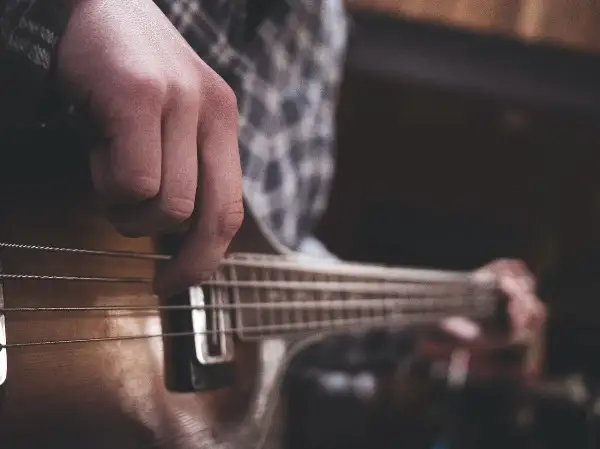
To top it all off, recording bass guitar direct is one of the simplest recording methods available. You only need a minimal home studio setup to do so, including a DI box and an interface plugged into your computer.
I’ll get into a small list of my favorite DI boxes in a bit, but for now, let's talk about how to use one of these DI boxes.
To get started, simply use a ¼” instrument cable to connect your bass to the input on your DI box. Next, use an XLR cable to connect the XLR output on your DI box to the mic preamp on your interface.
You should be good to go!
So, why would I use a DI box instead of plugging directly into the hi-Z ¼” input on my audio interface?
If you can't afford a quality DI box or you don't feel like adding another piece of gear to your studio, the hi-Z input on your audio interface will work just fine.
However, it's important to note that most entry-level audio interfaces do not have hi-Z inputs with optimal transformer-based circuitry to deliver the best end clearest bass sound.
Bassists use external DI boxes to properly manage the characteristics of instrument level signals, introducing a slight bit of desirable color and warmth while protecting from electrical and other noise.
A Few Best Practices for Recording Bass Guitar DI
While recording DI bass couldn't be simpler, there are a few small things to keep in mind if you want the best sound.
- Use the Right DI - If you have active electronics in your bass guitar, use a passive DI. If you have passive pickups in your bass guitar, use an active DI.
- Use a Buffer - If you're planning on connecting thru output on the DI box to an amplifier, use a buffer or a buffered effects pedal in bypass, so you don't overload your amp.
- Consider Phase - If you're combining amp and DI signals, try to invert the polarity of the preamp if your sound is lacking low-end. It's often the case that the signals are out of phase if they sound thin.
- Use a Quality Amp Sim - If you don't have a real amplifier to record in your studio, consider using an amp simulator plug-in. These amp sims make it easy to blend an unaffected DI signal with a processed signal. Plus, you don't have to commit to a tone before you get into the mixing phase.
How To Mix DI Bass
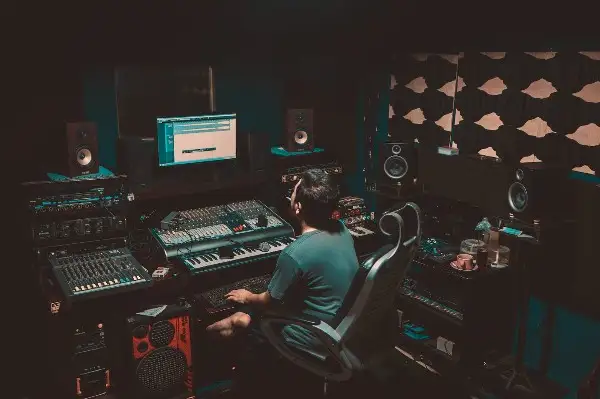
Ask any mixing engineer, and they'll give you a completely unique approach to mixing DI bass guitar. This is because there are near-infinite variables to consider, such as different bass guitars, different DIs, different genres, in different playing styles. It's almost impossible to guarantee that any mixing techniques will work for every situation.
With that said, there are a few DI bass mixing tips that I've carried with me throughout the years that are somewhat universally applicable:
- Mix In Context - While I will often solo my bass to look for bad notes or strange, unwanted noises, I will always adjust the volume and tone in context with the rest of the instrumentation. The way a DI bass sounds on its own is irrelevant to the entirety of the song.
- Mix Low - The way we perceive bass level can change drastically as we increase playback volume. This is why I always suggest mixing at a low volume to leave the sound of the room out of the equation as much as possible.
- Use Wide-Band EQ - If you need to EQ your bass in the lower octaves, I recommend using wide-band EQ. Narrow bands can be helpful if you're looking to address specific dead spots or resonant peaks, though too many narrow EQ cuts and boosts can begin to affect individual notes instead of overall tonality.
- Use Clip Gain - Go through your DI bass track and use clip gain or volume automation to even out the levels in your performance before running it into a compressor. You'll end up with a much smoother performance that will allow the compressor to work less dramatically.
Top DI Boxes for Bass Guitar
In reality, you can use just about any general-purpose DI for recording bass at home. However, over the years, manufacturers have made specific devices that are best suited for capturing the unique characteristics of a bass guitar.
Don't feel like you need to spend hundreds of dollars to get a premium DI if you want the best sound. A budget-friendly DI will do the job nicely, giving you a crisp and clear sound that you can further process in your DAW.
With that said, let's take a look at some of my top picks for bass DIs.
Tech 21 SansAmp Bass Driver DI
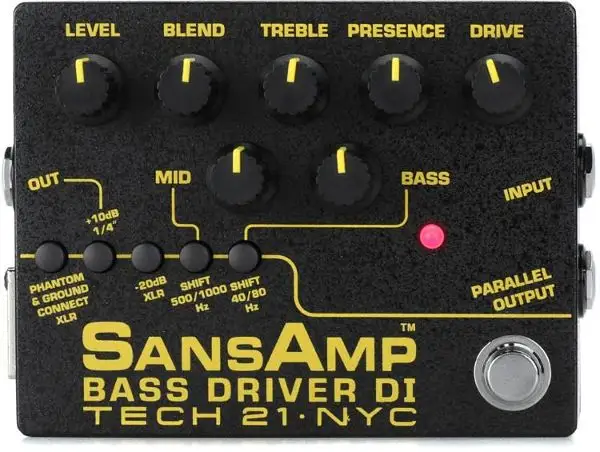
I could truly end this list with the Tech 21 SansAmp, as, in my experience, it is the only DI I've ever truly needed. Many refer to it as the ultimate DI for bassists, thanks to the fact that it's ultra-flexible and sounds incredible.
You'll find plenty of features packed into this little piece of hardware, allowing you to dial in any bass tone that your heart desires.
In reality, the SansAmp Bass Driver is so much more than a DI - it’s a tone-shaping device.
You can dial in a vast range of tones with the SansAmp, from traditional DI bass tones to gritty, distorted, tube-like tones. Under the hood, you'll find Tube Amplifier Emulation circuitry, meaning you can use it as an amplifier to derive a more interesting town from your otherwise sterile DI.
On the left side of the box, you'll find a handy Blend control, allowing you to blend in as much of the emulated tone as you desire.
If you look at the back of the DI box, you'll find a few different output options, including a ¼” jack and an XLR. There's also an unaffected ¼” output, which you can use to send the bass signal to your amplifier.
If you're just stepping foot in the world of DIs, the number of controls can be a bit overwhelming. However, if you can get past the learning curve, you'll have a DI bass pedal that you can grow and continue to enjoy for years to come.
Rupert Neve Designs RNDI
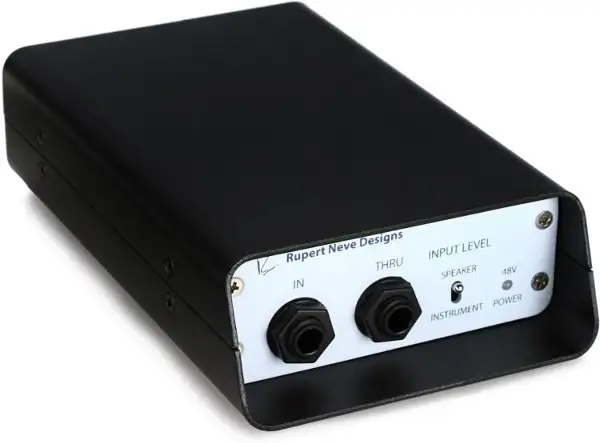
Rupert Neve is among the most prominent names in pro audio, and the Ruper Neve Designs RNDI is one of the highest-quality bass DIs on the market today.
You've likely heard the name Neve before, as Neve mixing consoles are some of the most iconic in recorded history and have made their way onto countless records. It makes quite a bit of sense that the Neve DI box would be just as good.
The first thing you'll notice is the minimalist design. It doesn't have as many features as some of the other DI box options on this list, though the little that it does, it does really well. This custom-designed Neve DI box uses class-A biased discrete FET amplifiers and iconic Rupert Neve Transformers, giving users a warm and harmonically dense bass sound with plenty of headroom.
Not only does it sound great for capturing DI bass, but it works equally well for recording guitars, keyboards, and more.
You can also DI the sound of your bass amp with the internal speaker, as it can take solid-state power up to 1,000 watts.
When all is said and done, if you're looking for an intuitive and high-end DI from a trusted name, look no further than the RNDI from Rupert Neve Designs.
Fishman Platinum Pro DI Preamp
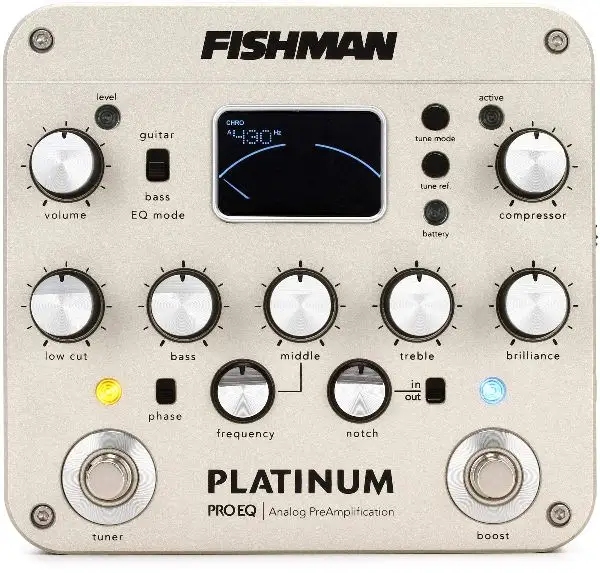
The Fishman Platinum Pro DI Preamp is so much more than your average DI box.
I highly recommend this little preamp for anyone who wants to streamline their current setup.
Beyond its use as a practical and robust DI box, it has a powerful onboard preamp with an integrated compressor, comprehensive EQ, and a built-in chromatic tuner. You truly don't need another device to get a beautiful DI bass tone.
The five-band onboard EQ is the main selling point for me, delivering a low-cut filter and a sweepable mid knob so you can be more precise with your tonal adjustments. This all-analog DI box also features an instrument switch to flip back and forth between the bass and guitar modes, while the compressor knob helps you dial in compression without any complicated parameters.
I've yet to find any other similar products that deliver this high level of tonal control, especially in the DI box market. In all, the Fishman Platinum Pro DI Preamp, in all its wonder, can deliver a dreamy, creamy bass tone with fantastic value.
Radial J48 MK2 Active Direct Box
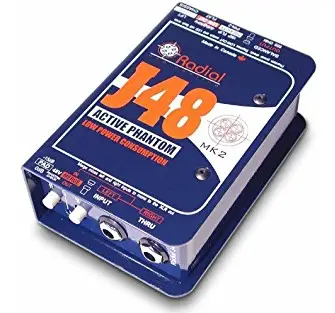
When it comes to pro audio, whether it's studio effects, reamp boxes, isolators, or splitters, Radial pretty much covers all of the bases.
The Radial J48 MK2 Active Direct Box is one you'll find in studios and venues all across the world, as it's one of the most heavy-duty and reliable DIs on the market. This little DI box delivers an ample amount of headroom and a unique merge switch that can sum stereo to mono.
The beauty of this DI is that it outputs the cleanest possible signal while providing bassists with an array of features to ensure that same clarity no matter where they find themselves playing. The J48 is unique in that it uses a power switch supply, expanding the internal rail voltage.
In English, you can inject this DI with 9V, giving users greater headroom and cleaner signals.
As you might expect with a name like “J48,” this DI box uses 48V phantom power. You do not need to have batteries to get it up and running.
It's equally useful for stereo instruments, such as synths and keyboards, as the DI box uses the merge function to make the Thru output an additional input, converting the stereo signal into mono before running it through XLR output.
With such a durable build, I highly recommend this active DI box for touring musicians. You get a clean electric bass guitar signal that your sound guy will thank you for.
Behringer Ultra-DI DI400P
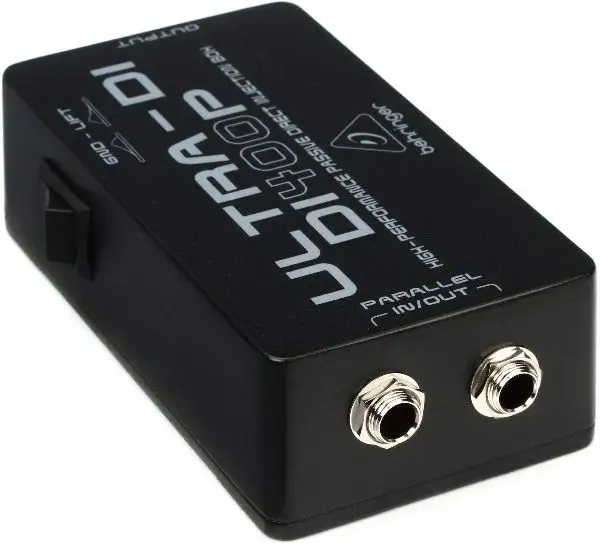
Behringer has received some flack over the years for its cheap reproductions of quality pro hardware. However, over the past couple of years, the company has started to put out some undeniably enticing pieces of gear for budget-minded buyers.
Many of us will never need a DI box with all the bells and whistles. All we need is a simple DI box that can get the job done, and the Behringer Ultra-DI DI400P can do it well. With a passive design, it's an excellent choice for guitar, bass, keyboards, and more.
It also works for blocking out noise, thanks to the handy ground lift switch.
One of the truly valuable characteristics of this DI is that even with its portable size, it packs in parallel ¼” inputs and outputs, allowing you to split your signal and send part of it to an amplifier while you use the XLR output to send the balanced signal to your interface or mixer.
FAQ
Are All DI Boxes the Same?
Not in the slightest!
Think about a DI box like you would think about a stompbox pedal. You might use a distortion or compression pedal over another because you like the way that it sounds. The same thing can be said for DI boxes.
Some DI boxes are made to deliver a clean and uninterrupted tone for further processing down the line, while others impart their own unique characteristics, delivering harmonic saturation or compression to give you a fuller and more rounded tone right off the bat.
As you can see from the list of DI boxes above, many of these pieces of hardware provide completely unique features and functionalities.
Should I Use a DI Box On Stage?
If you gig regularly, then you've probably played in both good and bad rooms.
A bad room is easy to spot right away, as it often has a buildup of unwanted frequencies, standing waves, and echo issues. One of the reasons a DI is so handy is that you can use it to tweak your town in a way that offsets the poor sound of a bad room.
Ask just about any sound guy, and they'll tell you they much prefer mixing DI boxes than amps, as DIs are much friendlier with mixing consoles.
Inject It, Respect It - Final Thoughts on DI
If you're a bassist or often record bass, you should think of a DI as an essential piece of gear for your studio.
If you want to lay down the best basslines and create a crisp, clear, and solid foundation for your recordings, check out some of the options above to get started.
Recording DI bass is so easy, which is one of the reasons I love it so much. Many industry-standard recording techniques can be a bit complicated or require a learning curve, so why not take advantage of one of the few that you can set up in just minutes?
Start laying down the best bass tones of your life today!





